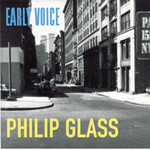
Early Voice
 $40.00
Out of Stock
$40.00
Out of Stock6+ weeks add to cart
PHILIP GLASS
Early Voice
Mabou Mines Theater Company / The Western Wind / Michael Riesman
[ ORANGE MOUNTAIN MUSIC / CD ]
Release Date: Tuesday 25 March 2008
This item is currently out of stock. It may take 6 or more weeks to obtain from when you place your order as this is a specialist product.
By the time Philip Glass wrote the music on this CD; Music for Voices in 1970, and Another Look at Harmony, Part 4 in 1970-1975, he had already established his voice as one of the main architects of the minimalist music movement.
Continuing with our series of releases from the archive of Philip Glass recordings, we bring you "Early Voice".
By the time Philip Glass wrote the music on this CD; Music for Voices in 1970, and Another Look at Harmony, Part 4 in 1970-1975, he had already established his voice as one of the main architects of the minimalist music movement. Though he disparages the term, minimalist, he has accepted the classification, but with the distinction that it only applies only to his earliest pieces, those up to and including Music in Twelve Parts.
This fine live performance of Music for Voices, sung by Mabou Mines at the Paula Cooper Art Gallery in 1972 is one of the earlier recordings that we have in our archive of Philip Glass material. In the late 60's and early 70's most of Philip Glass' performances took place in lofts and art galleries in Soho and lower Manhattan. Paula Cooper's Art Gallery was the first art gallery in that neighborhood of empty warehouses, trucks and sweatshops. Mabou Mines is an avant-garde theater company established in 1970 and continues to this day. Glass, a founding member of Mabou Mines, was the musical director for the group and this piece is possibly the 2nd or 3rd piece out of a dozen that he created for Mabou Mines productions.
The repeating patterns of Music for Voices were assembled into an informal score which divided the performers into pairs. In this performance eight people sat in a circle facing inwards. Each singer's part rose and fell in volume in a regular pattern and the entry of each voice coincided with the dynamic peak of its partner. The use of solfage as text for the unaccompanied vocal parts is a hint as to what is coming later in Music in 12 Parts and the groundbreaking Einstein on the Beach. The handclapping heard on this recording is Philip Glass signaling to the performers when to start the next pattern.
The other piece of music found on this disk is a 1989 recording produced by Michael Riesman of the transitional Another Look at Harmony, Part 4. This piece is scored for chorus and electric organ. The organ is played by Michael Riesman and the vocals are skillfully handled by the Western Wind. Referring to Music in Twelve Parts, Philip Glass states "I had worked 8 or 9 years creating a system, and now I'd written through it and come out the other end.
My next piece was called Another Look at Harmony and that's just what it was. I'd taken everything out with my early works and it was now time to decide what I wanted to put back in - a process that would occupy me for several years to come." This piece marks the arrival of harmonic motion but not a departure from the structural concerns and rhythmic intricacy of the earlier work - leading us right up to the watershed, Einstein on The Beach.
Tracks:
1. Music for Voices 13:26
2. Another Look at Harmony, Part 4 50:10

